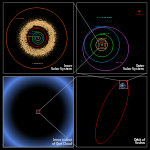 |
This is a file from the Wikimedia Commons. Information from its description page there is shown below.
Commons is a freely licensed media file repository. You can help.
|
 |
File:Oort cloud Sedna orbit.svg is a vector version of this file.
It should be used in place of this raster image when superior.
File:Oort cloud Sedna orbit.jpg  File:Oort cloud Sedna orbit.svg
For more information about vector graphics, read about Commons transition to SVG.
There is also information about MediaWiki's support of SVG images.
|
|
| Description |
These four panels show the location of trans-Neptunian object 90377 Sedna, which lies in the farthest reaches of the Solar system. Each panel, moving clockwise from the upper left, successively zooms out to place Sedna in context. The first panel shows the orbits of the inner planets and Jupiter; and the asteroid belt.
In the second panel, Sedna is shown well outside the orbits of Neptune and the Kuiper belt objects.
Sedna's full orbit is illustrated in the third panel along with the object's location in 2004, nearing its closest approach to the Sun. The final panel zooms out much farther, showing that even this large elliptical orbit falls inside what was previously thought to be the inner edge of the spherical Oort cloud: a distribution of cold, icy bodies lying at the limits of the Sun's gravitational pull. Sedna's presence suggests that the previously speculated inner disk on the ecliptic does exist. |
| Date |
15 March 2004 |
| Source |
Splitzer Space Telescope Released Images about Sedna |
| Author |
Image courtesy of NASA / JPL-Caltech / R. Hurt Original text courtesy of NASA / JPL-Caltech |
Permission
( Reusing this file) |
| Public domainPublic domainfalsefalse |
 |
This file is in the public domain because it was solely created by NASA. NASA copyright policy states that "NASA material is not protected by copyright unless noted". (See Template:PD-USGov, NASA copyright policy page or JPL Image Use Policy.) |
|
|
|
Warnings:
- Use of NASA logos, insignia and emblems are restricted per US law 14 CFR 1221.
- The NASA website hosts a large number of images from the Soviet/ Russian space agency, and other non-American space agencies. These are not necessarily in the public domain.
- Materials based on Hubble Space Telescope data may be copyrighted if they are not explicitly produced by the STScI. See also {{ PD-Hubble}} and {{ Cc-Hubble}}.
- The SOHO (ESA & NASA) joint project implies that all materials created by its probe are copyrighted and require permission for commercial non-educational use.
- Images featured on the Astronomy Picture of the Day (APOD) web site may be copyrighted.
|
|
References
- JPL. Most Distant Object in Solar System Discovered. Press release: Jet Propulsion Laboratory. March 15, 2004.
File usage
The following pages on Schools Wikipedia link to this image (list may be incomplete):
All five editions of Schools Wikipedia were compiled by SOS Childrens Villages. The world's largest orphan charity, SOS Children's Villages brings a better life to more than 2 million people in 133 countries around the globe. Help another child by taking out a sponsorship.







